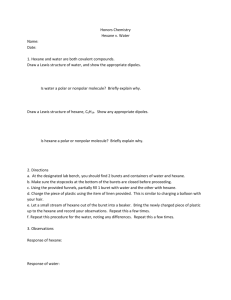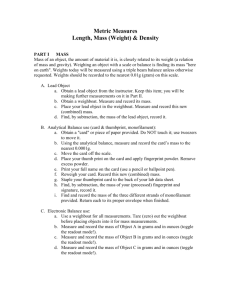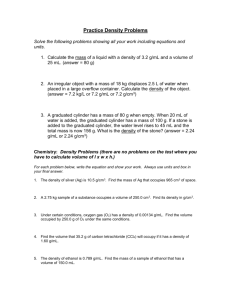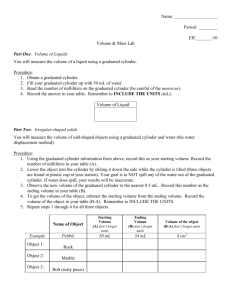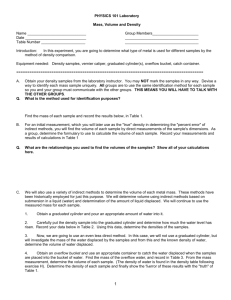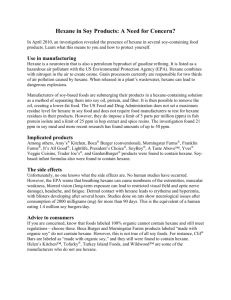Density of Unknowns Lab Report: Aluminum, Copper, Hexane
advertisement
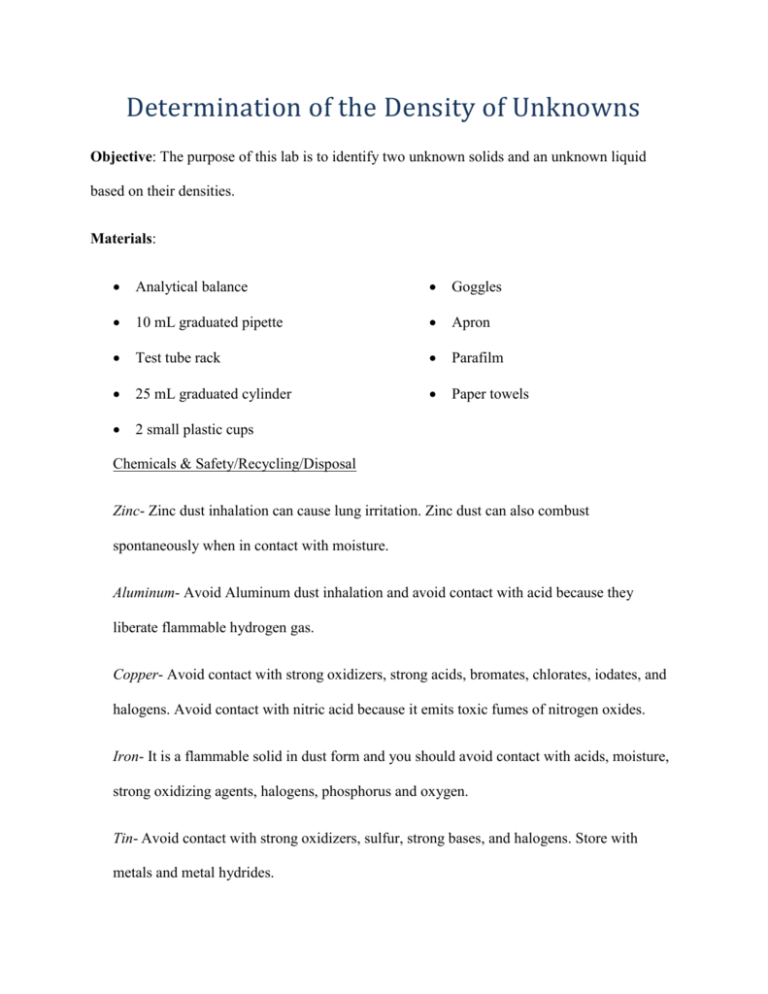
Determination of the Density of Unknowns Objective: The purpose of this lab is to identify two unknown solids and an unknown liquid based on their densities. Materials: Analytical balance Goggles 10 mL graduated pipette Apron Test tube rack Parafilm 25 mL graduated cylinder Paper towels 2 small plastic cups Chemicals & Safety/Recycling/Disposal Zinc- Zinc dust inhalation can cause lung irritation. Zinc dust can also combust spontaneously when in contact with moisture. Aluminum- Avoid Aluminum dust inhalation and avoid contact with acid because they liberate flammable hydrogen gas. Copper- Avoid contact with strong oxidizers, strong acids, bromates, chlorates, iodates, and halogens. Avoid contact with nitric acid because it emits toxic fumes of nitrogen oxides. Iron- It is a flammable solid in dust form and you should avoid contact with acids, moisture, strong oxidizing agents, halogens, phosphorus and oxygen. Tin- Avoid contact with strong oxidizers, sulfur, strong bases, and halogens. Store with metals and metal hydrides. Acetone- This is a dangerous fire hazard from heat, flame or strong oxidizers. Please store in a dedicated flammables cabinet with ethers, ketones, halogenated hydrocarbons and ethylene oxide. Use and dispense in a hood. Hexane-This is a flammable liquid and should be stored in a cool dry place with hydrocarbons, esters and aldehydes. Use and dispense in a hood. MSDS Source: http://www.flinnsci.com Procedure: Part A – Density of a Solid 1) Measure the mass of an empty small plastic cup. Zero the scale. 2) Measure the combined mass of the unknown solid in the small plastic cup. Record data. Repeat this procedure two more times. 3) Fill your graduated cylinder with 10 mL of water. Place the solid in the graduated cylinder and note the displacement of water. Tap out the bubbles if any. Record your data. 4) Dry solid with a paper towel. Calculate the density of the solid. Repeat procedures 3 and 4 two more times. Part B – Density of a Liquid 1) Measure the combined mass of a small beaker, a test tube, and a piece of para film. Zero the scale. 2) Obtain 7.55 mL of your unknown liquid into the test tube and quickly seal it with a piece of parafilm. 3) Measure the combined mass of your beaker, the filled test tube, and the slip of parafilm. Record your data and calculate the density of the liquid. 4) Repeat procedures 1 through 4 one more time, using only 5.42 mL of fluid this time. Data: Observations: Small, silver colored pellets Trials Mass of Solid #1 Volume of Solid #1 Density of Solid #1 1 19.86 grams 7 mL 3 g/mL 2 19.84 grams 7 mL 3 g/mL 3 19.85 grams 7 mL 3 g/mL Observations: Multiple dark brown, small sphere Trials Mass of Solid #2 Volume of Solid #2 Density of Solid #2 1 45.95 grams 4.9 mL 9.4 g/mL 2 45.95 grams 5.0 mL 9.2 g/mL 3 45.95 grams 5.0 mL 9.2 g/mL Trials Mass of Liquid Volume of Liquid Density of Liquid 1 4.99 grams 7.55 mL 0.661 g/mL 2 3.55 grams 5.42 mL 0.655 g/mL Observations: Clear Liquid Questions: 1) Identify your unknown solid sample and support your answer. Solid #1 is Aluminum because the experimental density of 3 g/mL comes the closest to the accept value of 2.7 g/mL. Observations also show that this solid has a similar silver color characteristic of Aluminum. Solid #2 is Copper because the average experimental density of 9.3 g/mL comes the closest to the accept value of 8.92 g/mL. 2) Identify your unknown liquid sample and support your choice. The unknown liquid is Hexane because the average experimental density of 0.658 g/mL comes the closest to the accept value of 0.659 g/mL. 3) Calculate the average deviation of your density values for your unknown liquid samples. 1. |0.661 – 0.7| = 0.039 ≈ 0.04 |0.655 – 0.7| = 0.045 ≈ 0.05 2. 0.04 + 0.05 2 = average deviation = 0.045 ≈ 0.05 4) A student has equal masses of each of the unknown liquids; acetone and hexane. Which liquid would have the largest volume? Explain your reasoning Hexane would have the largest volume because it is less dense. 𝑚𝑎𝑠𝑠 1. Density = 𝑣𝑜𝑙𝑢𝑚𝑒 2. Density of Acetone = 0.785 g/mL 3. 0.785 g/mL = 1.00 𝑔𝑟𝑎𝑚 𝑣𝑜𝑙𝑢𝑚𝑒 4. Volume of Acetone = 1.27 mL Density of Hexane = 0.659 g/mL 0.659 g/mL = 1.00 𝑔𝑟𝑎𝑚𝑠 𝑣𝑜𝑙𝑢𝑚𝑒 Volume of Hexane = 1.52 mL 5) The specific gravity of mercury, Hg, is 13.60 relative to water. What volume of mercury would have the same mass as 476 mL of water? 1. 1.0 g/mL = 476 𝑔𝑟𝑎𝑚𝑠 𝑜𝑓 𝑤𝑎𝑡𝑒𝑟 5. Density of Mercury = 13.6 g/mL 476 𝑚𝐿 𝑀𝑎𝑠𝑠 2. Density of water = 1.0 g/mL 6. Density = 𝑉𝑜𝑙𝑢𝑚𝑒 3. Specific Gravity of Mercury = 13.6 7. 13.6 g/mL = 476 𝑔𝑟𝑎𝑚𝑠 𝑉𝑜𝑙𝑢𝑚𝑒 4. Specific Gravity = 𝐷𝑒𝑛𝑠𝑖𝑡𝑦 𝑜𝑓 𝑆𝑢𝑏𝑠𝑡𝑎𝑛𝑐𝑒 Volume = 35 mL of Hg 𝐷𝑒𝑛𝑠𝑖𝑡𝑦 𝑜𝑓 𝑊𝑎𝑡𝑒𝑟 Conclusion: With the calculation of the densities of two solids and a liquid, it has been concluded that the three unknowns were Aluminum, Copper, and Hexane. The solids were measured for their mass with an analytical balance and measured for volume using water displacement in a graduated cylinder. The liquid’s volume was determined by how much was obtained from the buret. The liquid’s mass was measured through the combined mass a test tube holding the liquid, a beaker, and a piece of para film. Each substances’ mass and volume was recorded to calculate its density. The determination of the substance was concluded by comparing the how close the experimental values came to accepted values. Physical characteristics were also taken into consideration when determining the substance. The density of the first solid was 3 g/mL and was noted in having a shiny silver appearance. This solid resembles Aluminum, which has density of 2.7 g/mL and is also shiny and silver. The density of the second object was 9.3 g/mL and had a brownish color. This resembles to Copper, which has a density of 8.92 g/mL and possesses a brownish color. The density of the liquid was 0.658 g/ml, which closely resembles to Hexane’s accepted value of 0.659 g/mL. Some factors that could have resulted in errors for the experiment involve the analytical balance, the graduated cylinder, and the buret. The analytical balance could measure to the nearest one-hundredth, but it could not measure to the nearest one-thousandth. This rounded answer for mass affects the calculation of the density. Another error that could have occurred was bubble formation in the water of the graduated cylinder. These bubbles could have thrown off the reading for the volume of the solids. It is also possible that the buret was not calibrated correctly, and gave incorrect readings of volume. To obtain better results in future experimentation, a more sophisticated analytical balance should be used to get more accurate mass results for the solid. More trials should be done for each sample as well to ensure accuracy. From the lab, one can confidently determine the three unknowns to be Aluminum, Copper, and Hexane, but take steps to improve the experiment to get more accurate results. Sources of Error: Percent Error for Solid #1: 1. Error = 3 g/mL – 2.7 g/mL = 0.3 g/mL 2. Percent Error = | 0.3 𝑔/𝑚𝐿 | 2.7 𝑔/𝑚𝐿 × 100% = 10% Percent Error for Solid #2: 1. Error = 9.3 g/mL – 8.92 g/mL = 0.4 g/mL 2. Percent Error = | 0.4 𝑔/𝑚𝐿 | 8.92 𝑔/𝑚𝐿 × 100% = 4% Percent Error for Liquid 1. Error = 0.658 g/mL – 0.659 g/mL = -0.001 2. Percent Error = |−0.001 𝑔/𝑚𝐿 | 0.659 𝑔/𝑚𝐿 × 100% = 0.2%





